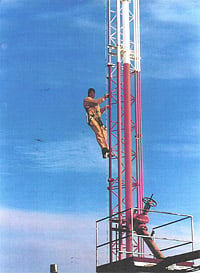Vertical Lifelines: A Guide to Proper Use, Maintenance and Inspection
Vertical lifelines are an important part of the fall protection system for workers using fixed ladders or similar climbing surfaces that are part of a structure, such as water tanks and antenna towers. Vertical lifelines allow the worker to move up and down the entire height of the line rather than having to disconnect and find a new tie-off point. Here are basic tips for proper use, maintenance, and inspection of fall protection vertical lifeline systems that will keep your workers safe and your equipment in good working order.
Vertical lifelines — also known as a cable ladder safety systems — are not intended for use on portable ladders, and should not be used on ladders less than 75 degrees from horizontal. The number of users allowed on a vertical lifeline system at one time ranges from one to four users, depending on the type of system and installation.
A full body harness with front D-ring should be used with vertical lifelines. The harness attaches to the lifeline with a shuttle/sleeve deceleration device that travels along with the worker as they move higher or lower. A body belt is not recommended due to the risk of unintentional release and possible suffocation because of improper body support.
Using Vertical Lifelines with a Climb Assist System
When using vertical lifeline systems with a climb assist system, you should consult the climb assist system manufacturer’s instructions for any restrictions or limitations concerning simultaneous use of these systems. Some connection combinations may interfere with proper operation of the vertical lifeline components and may result in failure to arrest a fall.
Inspection of Vertical Lifelines
All the components of a vertical lifeline system should be inspected regularly. Inspection of the ladder structure and of the body harness should be done according to the manufacturers’ instructions. An inspection of the vertical lifeline installation should take in the top and bottom brackets, cable guides, carrier cable, and fasteners. When inspecting the safety sleeve, look at the handle and cable shoe, fasteners, locking lever, rollers, and gravity stop. Also check to make sure that all service labels and markings are present and fully legible.
Workers should inspect the vertical lifeline, ladder structure, and body harness before each use. They should verify that the system has been formally inspected within the last year.
A formal inspection of the ladder safety sleeve, installation, and the ladder structure must be performed at least annually by a “competent person” other than the user who has been certified by OSHA standards for this function.
If a fall occurs with the ladder safety sleeve or on the system, the entire system must be locked out, and a formal inspection of the entire system must be performed by a competent person other than the user. A separate fall protection system should be used during this inspection.
If inspection reveals an unsafe or defective condition, remove the ladder safety system or the safety sleeve from service and destroy it, or contact an authorized service center for repair.
Diversified Fall Protection offers routine inspection services and can also train and certify staff to inspect and maintain vertical lifeline equipment. Equipment inspected and approved by a competent person can then be documented as OSHA compliant.
Maintenance and Storage of Vertical Lifelines
In general vertical lifelines do not require scheduled maintenance, but should be cleaned or lightly oiled when appropriate. Store the detachable cable sleeve in a cool, dry, clean environment, out of direct sunlight or areas where chemical vapors exits. Thoroughly inspect the sleeve after extended storage.
Vertical Lifeline Safety Training and Rescue Plans
Even in the best of circumstances, accidents happen. As with all fall protection systems, a safety and rescue plan should be on file. Workers should be trained in how to use and inspect the fall protection equipment, and on what steps to take should a fall occur. Diversified Fall Protection can help you build a safety and rescue plan based on your needs.
Partnering with a certified company that understands fall protection regulations is an important step towards becoming OSHA compliant. Our years of design, fabrication, installation, and inspection of fall protection systems will keep your company compliant… and your employees safe. To learn more about fall protection vertical lifeline system inspection and certification, or to request a quote, contact DFP for more information.
Schedule an assessment with Diversified Fall Protection
Contact Us to request a fall safety review

b-1.jpg?width=1368&height=1340&name=Rail%20(175)b-1.jpg)


